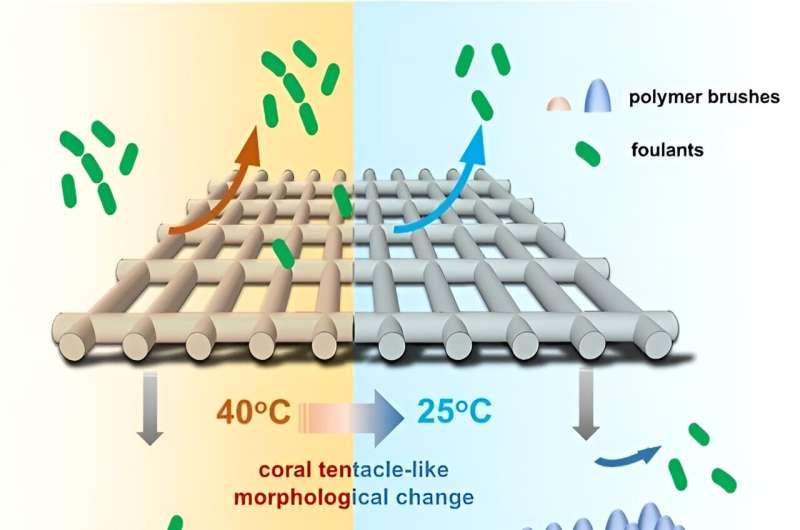This article has been reviewed according to Science X's editorial process and policies. Editors have highlighted the following attributes while ensuring the content's credibility:
fact-checked
trusted source
proofread
Researchers develop coral-tentacle-inspired antifouling membrane spacer

A research group led by Prof. Wan Yinhua from the Institute of Process Engineering (IPE) of the Chinese Academy of Sciences has developed a coral-tentacle-inspired antifouling membrane spacer through the sequential growth of functional polymer brushes on the spacer surface. The study was published in AIChE Journal.
Fouling of membrane spacers leads to an increased pressure drop and reduced lifespan for membrane modules. Cleaning these fouled spacers is challenging due to strong foulant–membrane spacer interactions.
Incorporating drugs into antifouling coatings enables the efficient inactivation of bacteria via drug release. However, antimicrobial surfaces are unsuitable for production processes like biofermentation–membrane separation. Additionally, they have the potential to promote the growth of drug-resistant bacteria due to extended inactivation times.
Through the course of natural evolution, corals have acquired distinct features marked by low surface energy and controllable morphology, endowing them with antifouling and self-cleaning properties. "Drawing inspiration from coral tentacles, we utilized atom transfer radical polymerization (ATRP) reactions to craft a morphology-controllable low surface free energy (LSFE) layer on the spacer surface, effectively enhancing the spacer's antifouling and self-cleaning characteristics," said Prof. Wan.
In a two-step ATRP reaction, temperature-responsive polymer brushes, specifically poly-N-isopropylacrylamide (PNIPAM), and antifouling fluorinated polymer brushes, known as poly-2-perfluorooctyl)ethyl methacrylate (PFOEMA), were consecutively immobilized onto the spacer surface. The modified spacer had lower surface energy, consequently reducing the adsorption of foulants.
In addition, PNIPAM imparted significant temperature responsiveness to the antifouling layer, enabling control over interfacial roughness and enhancing hydration capacity. The modified spacer reduced the pressure drop increment and foulant adsorption by 61.7 % and 89.3 %, respectively, in comparison to a commercially available polypropylene spacer.
"This innovative approach resolves the trade-off between anti-adsorption on fluorinated surfaces and hydrophobicity, providing valuable insights into microscale mass transfer control," said Prof. Luo Jianquan, corresponding author of the study. "We believe that this approach has the potential to provide guidance in various fields including preparation of antifouling membrane module, biosensor and immunoassays."
More information: Jiachen Huang et al, Coral‐tentacle‐inspired antifouling membrane spacer: A natural solution for biofouling prevention, AIChE Journal (2024). DOI: 10.1002/aic.18391
Provided by Chinese Academy of Sciences





















